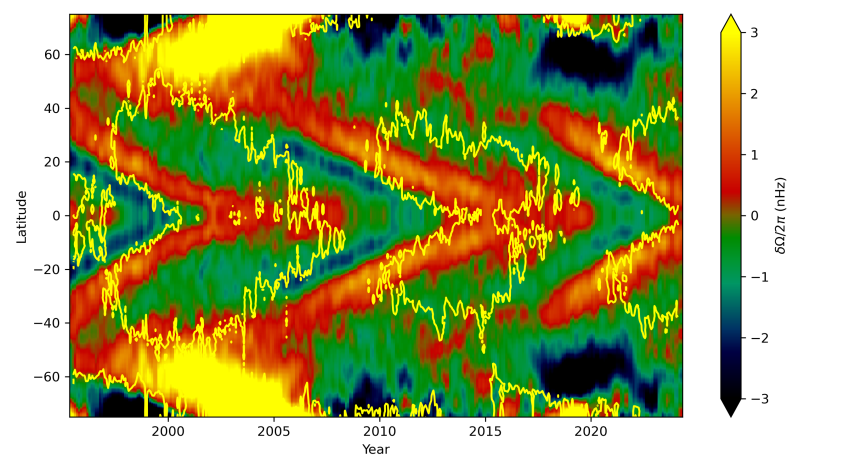The Sun has a main cycle of activity that lasts about 11 years. We count them from minimum to minimum. We are currently around the maximum of activity and that has been the main focus of scientists. This is a period of intense solar storms, as we saw back in May. But within that flurry of activity, the seed of the next cycle has appeared.
We are currently in Solar Cycle 25. It is the 25th since 1755 when the extensive recording of solar sunspot activity began. Sunspots are a way to keep track of cycles as they disappear during the minimum. But there are deeper changes that herald the beginning of the next cycle – and astronomers have just seen them.
You can’t see under the surface of the Sun with light, but we can see the patterns that these sound waves make at the surface.
Dr Rachel Howe
For almost 30 years, since 1995, researchers have used sound wave propagation within the Sun to study its interior motion. This is known as asteroseismology. Scientists have noticed that there is a pattern of bands that can rotate faster or slower and they move toward the equator and the poles during the cycle.
“You can’t see under the surface of the Sun with light, but we can see the patterns that these sound waves make at the surface,” Dr Rachel Howe, from the University of Birmingham, told IFLScience.

The red spots at the right edge of the graph are the first hint of Solar Cycle 26.
Image Credit: Rachel Howe
They are known as solar torsional oscillations. Data from Solar Cycles 23, 24, and 25 revealed that the faster bands tend to appear before the beginning of the next cycle. The pattern did not repeat exactly, but it gave confidence that this is something that consistently happens before the new cycle. And now astronomers have spotted them.
“Right up there at the edge, there’s just a little bit of red if you plot it like that [as in the figure above]. It is just about 11 years after the previous one, which is one solar cycle later. So that starts to look as though you know we might be just seeing that the very very beginning of what will eventually evolve into cycle 26,” Dr Howe told IFLScience.
It looks as though something is starting to propagate towards the equator. But we will need another year or two of observations to see it really clearly.
Dr Rachel Howe
The faster band moves at less than 1 percent faster than the average and they slowly move toward the equator. Analysis of the previous cycles has shown that these bands form a V-shape over the span of 11 years, moving from the mid-latitudes toward the equator. The conclusion is simple: Solar Cycle 26 is hinting its presence to us. It will begin around 2030.
“It looks as though something is starting to propagate towards the equator. But we will need another year or two of observations to see it really clearly,” Dr Howe told IFLScience.
Dr Howe presented the work at the Royal Astronomical Society’s National Astronomy Meeting in Hull.
Source Link: Sun Displays First Sign Of Next Solar Cycle – But We're In The Middle Of This One